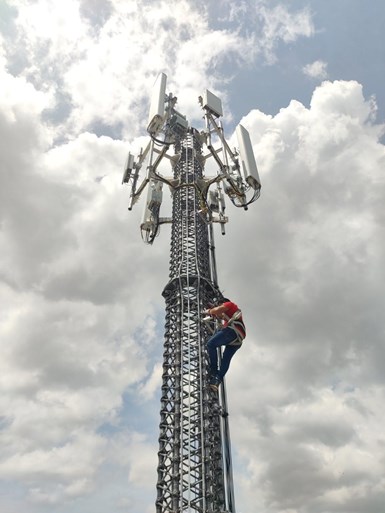Isotruss carbon fiber cell towers support global demand for 5G telecom rollout
Isotruss ramps up development of composite lattice cell towers which are twelve times stronger than steel towers, 1/12 their weight and reduce carbon emissions by 70%.

Photo Credit, all images: Isotruss Inc.
On Nov. 15, IsoTruss Inc. (Springville, Utah, U.S.) an engineering, design and manufacturing services provider, announced the production launch of its patented IsoTruss carbon fiber lattice cell towers. The towers are designed for telecom infrastructure providers to lower initial capital outlays, reduce labor, shipping and installation costs and solve issues with 5G distancing and speed of deployment.
“We are pleased to ramp up production of our IsoTruss carbon fiber cell towers to meet increasing telecom carrier acceptance and demand for cost-effective, ‘build-to-suit’ solutions to support full 5G rollout,” says Nathan Rich, CEO of IsoTruss Inc. “In our view, IsoTruss cell towers provide a crucial cost-effective alternative to steel towers for telecom infrastructure providers. Plus, structural composites potentially offer a multi-billion dollar market for cell tower retrofit and renovation.”
IsoTruss carbon fiber cell towers are reported to be twelve times stronger than steel, or 1/12 its weight, depending on the design and are are designed, engineered and tested to last at least five times longer than steel towers. Ranging in height from 6-42 meters, the composite IsoTruss cell towers are particularly suited to solve the “distancing” problem in 5G rollout, especially at sites with weight limits and zoning considerations, such as rooftops in densely populated urban settings, and in rural areas, which require “last-mile access.” Strength and wind resistance are maintained, no matter the height of the tower, the company adds.
Due to a high strength-to-weight ratio, and the need for little carbon fiber material to fabricate, Isotruss contends that the lattice towers also offer flexibility and modularity in structural design, even over other composite structures. Moreover, their light weight make them less expensive to ship as compared to steel towers, and reduces labor and installation costs — decreasing the time, expense and environmental impact of heavy equipment and large installation crews. Together, these reductions decrease cell tower carbon emissions by 70%, substantially lowering the total cost of ownership (TCO). This is important, says Isotruss, as the burgeoning demand for 5G connectivity grows; this demand will require hundreds of thousands strong, lightweight, cost-effective, wind-resistant and structurally sound cell towers.
“With the rising price of steel, IsoTruss carbon fiber cell towers are getting closer to parity on an apples to apples comparison,” says Cromwell Wong, chief operating officer at IsoTruss Inc. “The designs that we’re producing feature really lightweight, super strong, eco-friendly solutions with the aim of building the sustainable infrastructure of the future. Market conditions related to 5G technology developments combined with fast changing climate conditions are causing infrastructure decision-makers to place more emphasis on sustainability, and we think IsoTruss offers significant advantages through the reduction in carbon emissions versus steel build-outs.”

Full height of the Isotruss composite towers.
The original IsoTruss grid design, based on isosceles triangles, was invented by IsoTruss Inc. Chief Technical Adviser and Brigham Young University Professor Emeritus David W. Jensen, Ph.D. The carbon fiber lattice cell towers are designed by the firm’s team of engineers, all of whom are graduates of the Ira A. Fulton College of Engineering at Brigham Young University or the University of Utah.
Isotruss cell towers can be customized to customer specifications, while also meeting the firm’s own rigorous design and production standards, various local, state and federal regulations and Telecommunications Industry Association (TIA) and AASHTO standards. The lattice structures feature modularity in design, painting is optional and no electrolysis is required. Both fire-retardant resins and lightning protection systems can also be customized.
In October 2020, Sojitz Corp. (Tokoyo, Japan) announced its investment in IsoTruss Inc. through a third-party allotment of shares. The enterprise is working with Sojitz to accelerate the expansion of the telecommunication infrastructure business, primarily in Asia.
Related Content
The potential for thermoplastic composite nacelles
Collins Aerospace draws on global team, decades of experience to demonstrate large, curved AFP and welded structures for the next generation of aircraft.
Read MoreCarbon fiber in pressure vessels for hydrogen
The emerging H2 economy drives tank development for aircraft, ships and gas transport.
Read MoreOne-piece, one-shot, 17-meter wing spar for high-rate aircraft manufacture
GKN Aerospace has spent the last five years developing materials strategies and resin transfer molding (RTM) for an aircraft trailing edge wing spar for the Airbus Wing of Tomorrow program.
Read MorePEEK vs. PEKK vs. PAEK and continuous compression molding
Suppliers of thermoplastics and carbon fiber chime in regarding PEEK vs. PEKK, and now PAEK, as well as in-situ consolidation — the supply chain for thermoplastic tape composites continues to evolve.
Read MoreRead Next
From the CW Archives: The tale of the thermoplastic cryotank
In 2006, guest columnist Bob Hartunian related the story of his efforts two decades prior, while at McDonnell Douglas, to develop a thermoplastic composite crytank for hydrogen storage. He learned a lot of lessons.
Read MoreCW’s 2024 Top Shops survey offers new approach to benchmarking
Respondents that complete the survey by April 30, 2024, have the chance to be recognized as an honoree.
Read MoreComposites end markets: Energy (2024)
Composites are used widely in oil/gas, wind and other renewable energy applications. Despite market challenges, growth potential and innovation for composites continue.
Read More

























